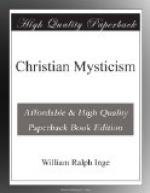It is not my purpose in these Lectures to attempt a historical survey of Christian Mysticism. To attempt this, within the narrow limits of eight Lectures, would oblige me to give a mere skeleton of the subject, which would be of no value, and of very little interest. The aim which I have set before myself is to give a clear presentation of an important type of Christian life and thought, in the hope that it may suggest to us a way towards the solution of some difficulties which at present agitate and divide us. The path is beset with pitfalls on either side, as will be abundantly clear when we consider the startling expressions which Mysticism has often found for itself. But though I have not attempted to give even an outline of the history of Mysticism, I feel that the best and safest way of studying this or any type of religion is to consider it in the light of its historical development, and of the forms which it has actually assumed. And so I have tried to set these Lectures in a historical framework, and, in choosing prominent figures as representatives of the chief kinds of Mysticism, to observe, so far as possible, the chronological order. The present Lecture will carry us down to the Pseudo-Dionysius, the influence of whose writings during the next thousand years can hardly be overestimated. But if we are to understand how a system of speculative Mysticism, of an Asiatic rather than European type, came to be accepted as the work of a convert of St. Paul, and invested with semi-apostolic authority, we must pause for a few minutes to let our eyes rest on the phenomenon called Alexandrianism, which fills a large place in the history of the early Church.
We have seen how St. Paul speaks of a Gnosis or higher knowledge, which can be taught with safety only to the “perfect” or “fully initiated";[110] and he by no means rejects such expressions as the Pleroma (the totality of the Divine attributes), which were technical terms of speculative theism. St. John, too, in his prologue and other places, brings the Gospel into relation with current speculation, and interprets it in philosophical language. The movement known as Gnosticism, both within and without the Church, was an attempt to complete this reconciliation between speculative and revealed religion, by systematising the symbols of transcendental mystical theosophy.[111] The movement can only be understood as a premature and unsuccessful attempt to achieve




